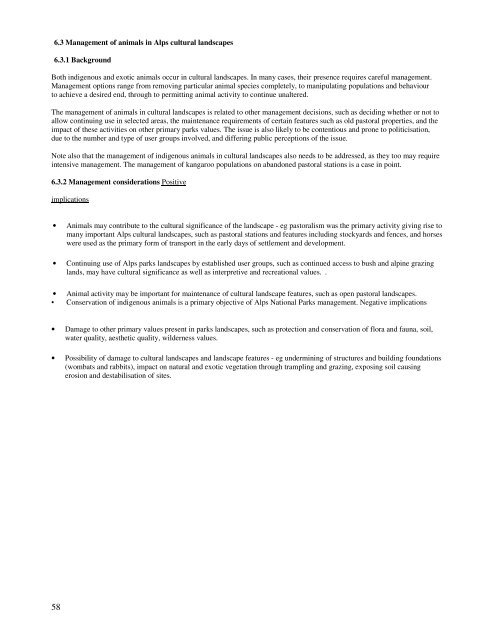Cultural Landscape Management - Australian Alps National Parks
Cultural Landscape Management - Australian Alps National Parks
Cultural Landscape Management - Australian Alps National Parks
You also want an ePaper? Increase the reach of your titles
YUMPU automatically turns print PDFs into web optimized ePapers that Google loves.
6.3 <strong>Management</strong> of animals in <strong>Alps</strong> cultural landscapes6.3.1 BackgroundBoth indigenous and exotic animals occur in cultural landscapes. In many cases, their presence requires careful management.<strong>Management</strong> options range from removing particular animal species completely, to manipulating populations and behaviourto achieve a desired end, through to permitting animal activity to continue unaltered.The management of animals in cultural landscapes is related to other management decisions, such as deciding whether or not toallow continuing use in selected areas, the maintenance requirements of certain features such as old pastoral properties, and theimpact of these activities on other primary parks values. The issue is also likely to be contentious and prone to politicisation,due to the number and type of user groups involved, and differing public perceptions of the issue.Note also that the management of indigenous animals in cultural landscapes also needs to be addressed, as they too may requireintensive management. The management of kangaroo populations on abandoned pastoral stations is a case in point.6.3.2 <strong>Management</strong> considerations Positiveimplications• Animals may contribute to the cultural significance of the landscape - eg pastoralism was the primary activity giving rise tomany important <strong>Alps</strong> cultural landscapes, such as pastoral stations and features including stockyards and fences, and horseswere used as the primary form of transport in the early days of settlement and development.• Continuing use of <strong>Alps</strong> parks landscapes by established user groups, such as continued access to bush and alpine grazinglands, may have cultural significance as well as interpretive and recreational values. .• Animal activity may be important for maintenance of cultural landscape features, such as open pastoral landscapes.• Conservation of indigenous animals is a primary objective of <strong>Alps</strong> <strong>National</strong> <strong>Parks</strong> management. Negative implications• Damage to other primary values present in parks landscapes, such as protection and conservation of flora and fauna, soil,water quality, aesthetic quality, wilderness values.• Possibility of damage to cultural landscapes and landscape features - eg undermining of structures and building foundations(wombats and rabbits), impact on natural and exotic vegetation through trampling and grazing, exposing soil causingerosion and destabilisation of sites.58
















